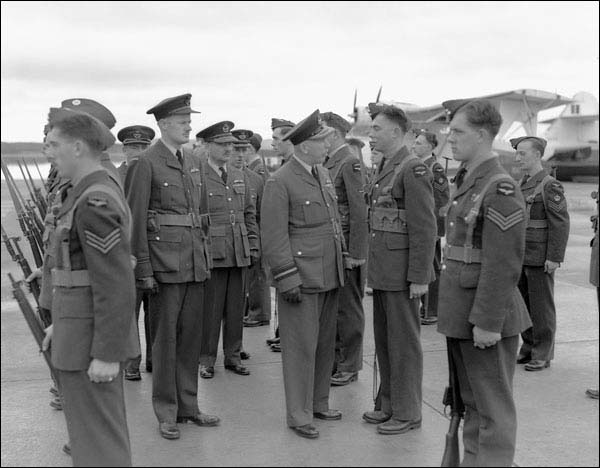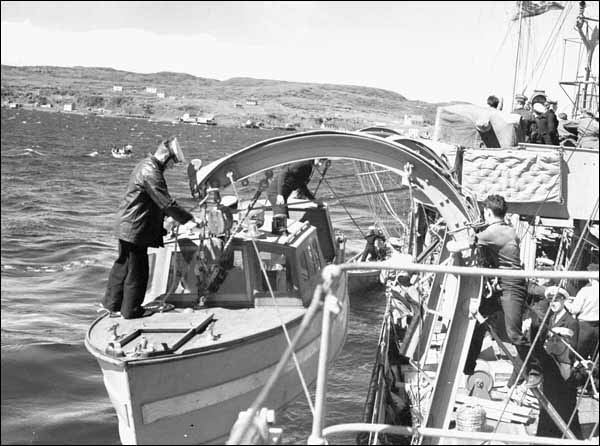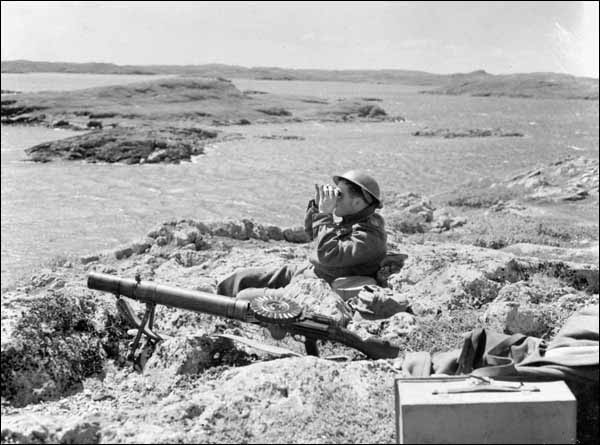Botwood
During the Second World War, the relatively quiet port of Botwood became a highly-militarized Canadian coastal defence base. Its strategic location in the North Atlantic, coupled with its already-existing seaplane base, made it an ideal jumping-off point for transatlantic flights. The community was home to thousands of soldiers throughout the war and played host to numerous dignitaries and celebrities, including British Prime Minister Winston Churchill and American performer Bob Hope.

However, it was before Botwood's transformation into a bustling centre of military activity that an enemy ship was captured in its port. When war was declared on September 3, 1939, the German freighter Christoph V. Doornum was docked in Botwood's harbour to load ore concentrate from the Buchans mine. Unable to depart because of a technical malfunction, the vessel was seized at approximately 11 a.m. by the Newfoundland Constabulary and some local residents. The ship's 25 crew members were taken to a prisoner of war camp in St. John's, while the freighter was removed to Halifax. The incident is considered to be the first act of war in North America during the Second World War.
In the coming months, Botwood witnessed increased military activity as Canadian soldiers arrived by the hundreds to defend the air base and build coastal gun batteries, ammunition bunkers, and numerous other facilities.
RCAF in Botwood
The establishment of a Royal Canadian Air Force (RCAF) base at Botwood had its beginnings in a 1935 agreement between Canada, England, and Ireland to develop a commercial transatlantic air service. Botwood was selected as a western terminus for seaplanes because of its sheltered deep-water harbour, which was largely ice-free from June to November. The community was also situated along the shortest air route between London and New York, known as the great circle route.
Construction of the Botwood airport began in the spring of 1936 and was completed the following year. The facilities included an administrative office, fuel storage space, maintenance buildings, a cafeteria, living accommodations and a passenger lounge. Technical equipment was also built to aid in aerial navigation. These included directional beacons, medium and high frequency radio transmitters, and meteorological facilities. The airport operated annually from May to mid-November, but closed each winter because of ice in the harbour.
Protection of the facility became a concern to Allied forces with the outbreak of war in 1939. Under Nazi control, the Botwood airport could seriously undermine western defences by allowing the Germans an entry point to North America. However, under Allied control, the airbase would be an important asset – its easterly position allowed reconnaissance flights to travel 450 miles further into the Atlantic than the nearest Canadian bases in Nova Scotia could permit.
Concerned that Newfoundland would not be able to adequately defend the airport without outside help, the Commission of Government sent a telegram to Britain on September 15 suggesting that the facility be turned over to RCAF control for the duration of the war. London initially refused the request, not wanting to lose post-war control of the airport, but gave way in the spring of 1940, after Nazi forces gained strength in Europe.

Canadian aircraft and ground forces arrived in Botwood by the end of June, including 852 men of Canada's Black Watch (a reserve infantry regiment), roughly half of whom were sent to Gander. The RCAF's primary missions in Botwood were to patrol the western portion of the Atlantic, provide early warning of enemy approach, defend Botwood in the event of attack, and support the civilian seaplane services, which continued until the end of the war. The Army's mission was to protect the Botwood airbase and ensure its continued operation.
The Base
Anticipating an increase in the number of troops and aircraft passing through Botwood, the RCAF decided in August 1940 to expand the existing facilities. Workers were ordered to build a large concrete slipway, two seaplane hangars, and create more parking space. Construction also started on a hospital, barracks, warehouses, repair shops, mess halls, a water supply and various other facilities.
To better defend the base from attack, the Canadian Army built two gun batteries at nearby Phillip's Head and Wiseman's Cove. Overlooking the Bay of Exploits, these guns were intended to prevent enemy naval vessels from entering the port. Temporary barracks, messes, storage, and generator buildings were also built on site.
The artillery station constructed at Phillip's Head was elaborate in scope. It boasted a three-storey lookout tower and a 700-foot underground passage that connected 11 rooms filled with ammunition, secret documents and supplies. The entire station was surrounded by barbed wire fencing and fitted with drain pipes intended to flood the facility in the event of enemy invasion. Booby traps were also set up along the underground passage and two hidden escape hatches were installed.

A large camouflaged steel net was also secretly submerged at the entrance to Botwood harbour. Its purpose was to prevent submarines from entering the port and to defend the area from torpedoes. At nearby Killick Island, underground ammunition storage caves were created and a causeway was built connecting it to the airbase.
In the summer of 1941, a detachment of twin-engine patrol bombers was stationed at Botwood to perform anti-submarine patrols over convoy lanes in the North Atlantic. When the base closed for the winter season, 27 RCAF officers and 383 soldiers were stationed at Botwood. One year later, 46 officers and 456 soldiers were at the base. It marked a dramatic change for a community that had a population of approximately 1,000 when the war began.
Alongside the increased military presence, Botwood residents had to adapt to a number of other wartime changes. Food staples, including sugar, tea, flour and beef, were scarce and had to be purchased with government-issued ration coupons. Blackouts became a common occurrence and sometimes lasted a week as civilians and soldiers prepared for possible air raids. In order to expand the base, the RCAF appropriated property belonging to several residents. Although compensation was paid, the emotional and financial burdens experienced by those forced to abandon their homes were tremendous. However, the Canadian military presence also created much employment for local residents – in 1942, for example, 86 civilians worked at the base.
Post-War
Between 1940 and 1945, approximately 10,000 soldiers had passed through Botwood. When the war ended, Canadian troops left their stations and returned home. All military buildings were sold, dismantled or relocated. The 100-bed hospital was sold to the Commission of Government for $1 in 1946 and served as a cottage hospital until its closure in 1989.
The large guns were removed from Wiseman's Cove and Phillip's Head, although their platforms still remain at the latter location. Any unused ammunition or supplies were cleared from all storage rooms and the underwater net was removed. Commercial seaplane service also ended in 1945, as land-based planes dominated the market. Today, both the airbase and the artillery station at Phillip's Head are historic sites.




